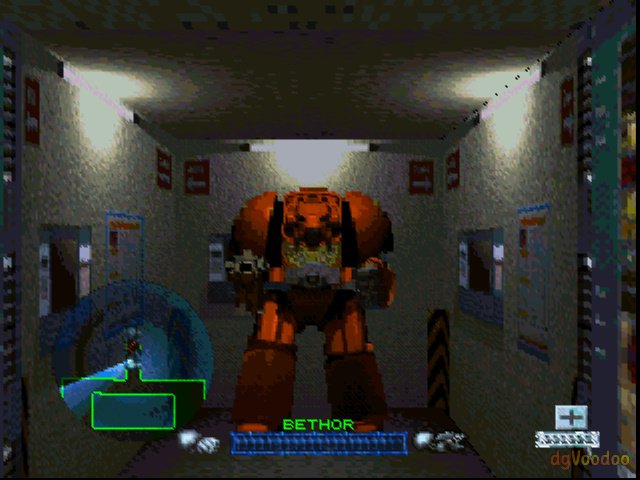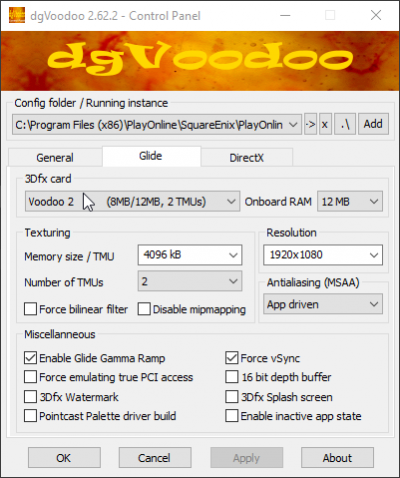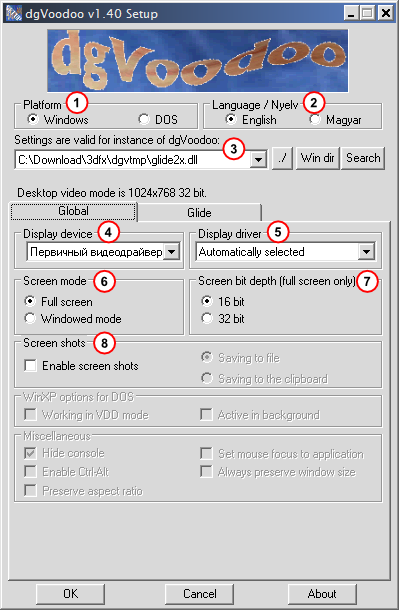Close all FFXI instances you have open. Download the latest version of dgVoodoo 2 and extract the archive. Open the MS x86 folder then select and copy the following files: D3D8.dll. Paste the files into the game installation folder where the game executable is. If you use Ashita, you'd paste these files to the.
- Fyi, latest versions of dgvoodoo led to strange white graphics on my AMD based setup. Using v2.55.4.1 solves the problem. I've opened a thread for this but I though this info could do no harm here. Edit: GK3 is not the only game concerned, though only with recent AMD cards, so a fix is in the making and future releases of dgvoodoo should work.
- DgVoodoo Link: video will show you how to setup DgVooDoo. DgVoodoo is a legacy DirectX and 3DF.
- Download DgVoodoo 2 from here: http://dege.freeweb.hu/dgVoodoo2/dgVoodoo2.html
- Extract the .zip
- Go into the extracted folder, and COPY the MSD3D8.dll file
- Go to your PlayOnline folder where your pol.exe is located, mine is at SquareEnixPlayOnlineViewer
- Paste the MSD3D8.dll file into your PlayOnline folder
- Open the dgvoodooCpl.exe in your DgVoodoo 2 folder
- Configure the DirectX settings based on what your machine can handle
- Launch FFXI, login, and enjoy!

The story is set in the fantasy world of Vana'diel, where player-created avatars can both compete and cooperate in a variety of objectives to develop an assortment of jobs, skills, and earn in-game item rewards. Players can undertake an array of quests and progress through the in-game hierarchy and through the major plot of the game. Since its debut in 2002, five expansion packs have been released along with six add-on scenarios. Each expansion pack and add-on brings a new major storyline to the Final Fantasy XI world, along with numerous areas, quests, events and item rewards.
In March 2015, Square Enix announced that Final Fantasy XI would receive one more final main scenario (spread out over three parts in 2015). The servers for the game PlayStation 2 and Xbox 360 versions will be shut down in 2016. A mobile client for the game is under development by Square Enix in collaboration with Korean developer Nexon,. A spinoff mobile game, Final Fantasy Grandmasters was released on September 30, 2015.
Subscribe! ► http://bit.ly/18P9B4D
Facebook ► https://www.facebook.com/TheGwardian
Twitter ► https://twitter.com/TheGwardian
Twitch ► https://www.twitch.tv/thegwardian
Subreddit ► http://www.reddit.com/r/TheGwardian/
Steam Curator Page ► http://store.steampowered.com/curator/6858385/
Buy the game at ► http://store.steampowered.com/app/230...
Developer: Square Enix
Release: October 28, 2003 (NA)
Genre: MMORPG
Platforms: PC, Xbox 360, PlayStation 2, Android & iOS.
Publisher: Square Enix (PC, Xbox 360), Sony Computer Entertainment (PlayStation 2)
https://www.paypal.me/JamesAndersonWebDev
Dgvoodoo 2 Setup Guide
Setting up LEGO Island is generally straightforward on PCs of its era, however some extra effort and considerations are sometimes required depending on how modern your system is.

- 1Installing
- 1.1Standard
- 2Playing LEGO Island
Installing
Standard
The stock installer located at INSTALL.EXE should run fine on any version of Windows (ignore SETUP.EXE as it's a 16-bit application that won't run on any 64-bit version of Windows). This will provide a fairly standard install of LEGO Island authentic to the era, with the obvious caveat that it doesn't take into account some extra steps required on modern versions of Windows:
D3DRM.DLL
Main article: Direct3D Retained Mode
From Vista onwards, D3DRM.DLL - a DLL required to run LEGO Island - was removed from Windows itself and has to be manually restored. While the DLL is on the LEGO Island CD (located at redistdirectxd3drm.dll), it's recommended to use a newer version that was released with Windows XP for better compatibility. You'll want to place D3DRM.DLL into LEGO Island's install folder (usually C:Program Files (x86)LEGO Island).
No-CD Patch
Main article: NOCD.SI
If you want LEGO Island to run without a CD, it's as simple as copying the Lego folder from the CD to LEGO Island's install folder (usually C:Program Files (x86)LEGO Island). You'll want to merge with the LEGO folder that already exists and don't worry about replacing the file NOCD.SI (it's the same file so skipping or replacing it makes no difference).
Japanese Version

Dgvoodoo Ffxi Setup
For unknown reasons, the Japanese LEGO Island installer features a version check that fails if the version of Windows you're using is not 4.x (e.g. 95, 98, or Me). This means the installer will fail on any Windows version newer (starting with Windows 2000). As such, for this version you should probably use the LEGO Island Alternative Installer.
Alternative Installer
A community alternative installer exists to make up for the shortcomings of the stock installer. It will automatically copy D3DRM.DLL from the CD as well as the LEGO folder if you select a 'Full' install. This is generally a much easier and more fool-proof option than the stock installer.
Playing LEGO Island
Persistent save data
Main article: Compatibility Issues
LEGO Island stores its save data in its program folder, which in modern software is a big no-no due to inherent security risks involved. From Windows Vista, access to the Program Files folder was restricted to administrator access only, preventing LEGO Island from saving game data. The solutions are generally as follows:
- Using LEGO Island Rebuilder. Rebuilder functions as a launcher that automatically redirects save data to a safe location so that administrator privileges are not required. This is the simplest and most recommended solution.
- Run LEGO Island as administrator. Relatively simple by right clicking LEGO Island and selecting 'Run as Administrator' or opening 'Properties', navigating to the 'Compatibility' and selecting 'Run as Administrator' so that the game is always run as administrator.
- Re-installing LEGO Island to a non-restricted location. Often this is a second drive on your PC or somewhere in your home folder. This will work, but may get complicated depending on where you choose to install it.
Turn speed
Main article: Turn Speed
LEGO Island infamously ties the turn speed to the frame rate, meaning the much faster computers of the day heavily impact the game's controls and playability. It's recommended to use LEGO Island Rebuilder which has parameters for separating the turn speed from the frame rate as well as changing the turn and walk speeds in general.

'To configure LEGO Island' doesn't save
This issue is similar to the save data not saving correctly but a slightly different presentation. In this scenario, the data is not being saved to the game's program folder, but rather the registry's HKEY_LOCAL_MACHINE hive - another section of Windows that has become more restricted in over time due to inherent security risks.
For some reason, running CONFIG.EXE as administrator doesn't seem to address this issue. It seems the only way to make it save configuration data is to set its compatibility mode to 'Windows 95' (right click > Properties > Compatibility tab).
General graphical glitches

The story is set in the fantasy world of Vana'diel, where player-created avatars can both compete and cooperate in a variety of objectives to develop an assortment of jobs, skills, and earn in-game item rewards. Players can undertake an array of quests and progress through the in-game hierarchy and through the major plot of the game. Since its debut in 2002, five expansion packs have been released along with six add-on scenarios. Each expansion pack and add-on brings a new major storyline to the Final Fantasy XI world, along with numerous areas, quests, events and item rewards.
In March 2015, Square Enix announced that Final Fantasy XI would receive one more final main scenario (spread out over three parts in 2015). The servers for the game PlayStation 2 and Xbox 360 versions will be shut down in 2016. A mobile client for the game is under development by Square Enix in collaboration with Korean developer Nexon,. A spinoff mobile game, Final Fantasy Grandmasters was released on September 30, 2015.
Subscribe! ► http://bit.ly/18P9B4D
Facebook ► https://www.facebook.com/TheGwardian
Twitter ► https://twitter.com/TheGwardian
Twitch ► https://www.twitch.tv/thegwardian
Subreddit ► http://www.reddit.com/r/TheGwardian/
Steam Curator Page ► http://store.steampowered.com/curator/6858385/
Buy the game at ► http://store.steampowered.com/app/230...
Developer: Square Enix
Release: October 28, 2003 (NA)
Genre: MMORPG
Platforms: PC, Xbox 360, PlayStation 2, Android & iOS.
Publisher: Square Enix (PC, Xbox 360), Sony Computer Entertainment (PlayStation 2)
https://www.paypal.me/JamesAndersonWebDev
Dgvoodoo 2 Setup Guide
Setting up LEGO Island is generally straightforward on PCs of its era, however some extra effort and considerations are sometimes required depending on how modern your system is.
- 1Installing
- 1.1Standard
- 2Playing LEGO Island
Installing
Standard
The stock installer located at INSTALL.EXE should run fine on any version of Windows (ignore SETUP.EXE as it's a 16-bit application that won't run on any 64-bit version of Windows). This will provide a fairly standard install of LEGO Island authentic to the era, with the obvious caveat that it doesn't take into account some extra steps required on modern versions of Windows:
D3DRM.DLL
Main article: Direct3D Retained Mode
From Vista onwards, D3DRM.DLL - a DLL required to run LEGO Island - was removed from Windows itself and has to be manually restored. While the DLL is on the LEGO Island CD (located at redistdirectxd3drm.dll), it's recommended to use a newer version that was released with Windows XP for better compatibility. You'll want to place D3DRM.DLL into LEGO Island's install folder (usually C:Program Files (x86)LEGO Island).
No-CD Patch
Main article: NOCD.SI
If you want LEGO Island to run without a CD, it's as simple as copying the Lego folder from the CD to LEGO Island's install folder (usually C:Program Files (x86)LEGO Island). You'll want to merge with the LEGO folder that already exists and don't worry about replacing the file NOCD.SI (it's the same file so skipping or replacing it makes no difference).
Japanese Version
Dgvoodoo Ffxi Setup
For unknown reasons, the Japanese LEGO Island installer features a version check that fails if the version of Windows you're using is not 4.x (e.g. 95, 98, or Me). This means the installer will fail on any Windows version newer (starting with Windows 2000). As such, for this version you should probably use the LEGO Island Alternative Installer.
Alternative Installer
A community alternative installer exists to make up for the shortcomings of the stock installer. It will automatically copy D3DRM.DLL from the CD as well as the LEGO folder if you select a 'Full' install. This is generally a much easier and more fool-proof option than the stock installer.
Playing LEGO Island
Persistent save data
Main article: Compatibility Issues
LEGO Island stores its save data in its program folder, which in modern software is a big no-no due to inherent security risks involved. From Windows Vista, access to the Program Files folder was restricted to administrator access only, preventing LEGO Island from saving game data. The solutions are generally as follows:
- Using LEGO Island Rebuilder. Rebuilder functions as a launcher that automatically redirects save data to a safe location so that administrator privileges are not required. This is the simplest and most recommended solution.
- Run LEGO Island as administrator. Relatively simple by right clicking LEGO Island and selecting 'Run as Administrator' or opening 'Properties', navigating to the 'Compatibility' and selecting 'Run as Administrator' so that the game is always run as administrator.
- Re-installing LEGO Island to a non-restricted location. Often this is a second drive on your PC or somewhere in your home folder. This will work, but may get complicated depending on where you choose to install it.
Turn speed
Main article: Turn Speed
LEGO Island infamously ties the turn speed to the frame rate, meaning the much faster computers of the day heavily impact the game's controls and playability. It's recommended to use LEGO Island Rebuilder which has parameters for separating the turn speed from the frame rate as well as changing the turn and walk speeds in general.
'To configure LEGO Island' doesn't save
This issue is similar to the save data not saving correctly but a slightly different presentation. In this scenario, the data is not being saved to the game's program folder, but rather the registry's HKEY_LOCAL_MACHINE hive - another section of Windows that has become more restricted in over time due to inherent security risks.
For some reason, running CONFIG.EXE as administrator doesn't seem to address this issue. It seems the only way to make it save configuration data is to set its compatibility mode to 'Windows 95' (right click > Properties > Compatibility tab).
General graphical glitches
Main article: Compatibility Issues
LEGO Island relies on various dated DirectX APIs that have seen numerous changes over the decades since its release. As such, using Direct3D HAL can result in various graphical glitches and crashes that impact the game's playability. To address this, it's recommended to either use a software mode instead ('Ramp Emulation', 'RGB Emulation', or 'MMX Emulation') as those are CPU-based and have therefore been largely unaffected by the changes to the Direct3D API, or to use dgVoodoo which translates LEGO Island's outdated DirectX 5 calls to modern DirectX 11 calls. This has the advantage of allowing other graphical tweaks too, such as increasing the resolution, adding anti-aliasing, overriding texture filtering, and more.
High-definition Patch
Main article: dgVoodoo
LEGO Island was only ever designed to run at 640x480 which was relatively standard at the time. Given the much larger variety of resolution available today, it may be desirable to run the game at a higher resolution. Currently, the best way to do this is with dgVoodoo, which allows users to override the resolution to one of their choosing. Note that this is unfortunately not a true widescreen patch, the game will still have a 4:3 aspect ratio that will get stretched to whatever resolution you choose. As such, it's recommended to use a 4:3 resolution to maintain LEGO Island's native aspect ratio (e.g. 1440x1080 instead of 1920x1080). Currently LEGO Island Rebuilder is working on a true widescreen patch to address this issue.

